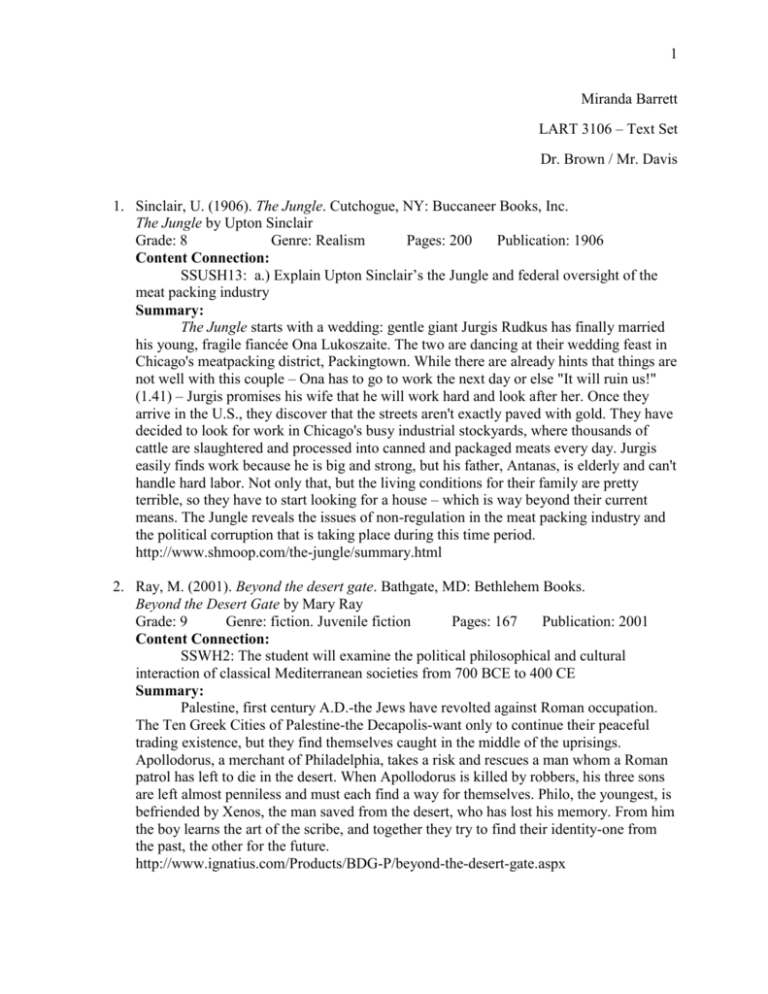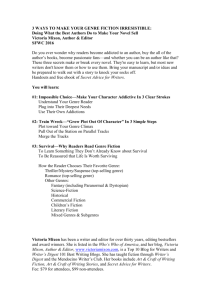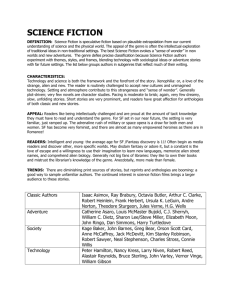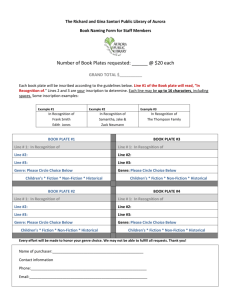Miranda Barrett LART 3106 – Text Set Dr. Brown / Mr. Davis Sinclair
advertisement

1 Miranda Barrett LART 3106 – Text Set Dr. Brown / Mr. Davis 1. Sinclair, U. (1906). The Jungle. Cutchogue, NY: Buccaneer Books, Inc. The Jungle by Upton Sinclair Grade: 8 Genre: Realism Pages: 200 Publication: 1906 Content Connection: SSUSH13: a.) Explain Upton Sinclair’s the Jungle and federal oversight of the meat packing industry Summary: The Jungle starts with a wedding: gentle giant Jurgis Rudkus has finally married his young, fragile fiancée Ona Lukoszaite. The two are dancing at their wedding feast in Chicago's meatpacking district, Packingtown. While there are already hints that things are not well with this couple – Ona has to go to work the next day or else "It will ruin us!" (1.41) – Jurgis promises his wife that he will work hard and look after her. Once they arrive in the U.S., they discover that the streets aren't exactly paved with gold. They have decided to look for work in Chicago's busy industrial stockyards, where thousands of cattle are slaughtered and processed into canned and packaged meats every day. Jurgis easily finds work because he is big and strong, but his father, Antanas, is elderly and can't handle hard labor. Not only that, but the living conditions for their family are pretty terrible, so they have to start looking for a house – which is way beyond their current means. The Jungle reveals the issues of non-regulation in the meat packing industry and the political corruption that is taking place during this time period. http://www.shmoop.com/the-jungle/summary.html 2. Ray, M. (2001). Beyond the desert gate. Bathgate, MD: Bethlehem Books. Beyond the Desert Gate by Mary Ray Grade: 9 Genre: fiction. Juvenile fiction Pages: 167 Publication: 2001 Content Connection: SSWH2: The student will examine the political philosophical and cultural interaction of classical Mediterranean societies from 700 BCE to 400 CE Summary: Palestine, first century A.D.-the Jews have revolted against Roman occupation. The Ten Greek Cities of Palestine-the Decapolis-want only to continue their peaceful trading existence, but they find themselves caught in the middle of the uprisings. Apollodorus, a merchant of Philadelphia, takes a risk and rescues a man whom a Roman patrol has left to die in the desert. When Apollodorus is killed by robbers, his three sons are left almost penniless and must each find a way for themselves. Philo, the youngest, is befriended by Xenos, the man saved from the desert, who has lost his memory. From him the boy learns the art of the scribe, and together they try to find their identity-one from the past, the other for the future. http://www.ignatius.com/Products/BDG-P/beyond-the-desert-gate.aspx 2 3. Tolkien, J. R. R. (1975). Sir Gawain and the green knight; Pearl and Sir Orfeo. New York, NY: The Random House Publishing Group. Sir Gawain and the Green Knight; Pearl; and Sir Orfeo by J.R.R Tolkien Grade: 10 Genre: Modern heroic fantasy Pages: 148 Publication: 1975 Awards: 2011 Bestseller Award Content Connection: SSWH7: The student will analyze European medieval society with regard to culture, politics, society and economics. Summary: Sir Gawain and The Green Knight, Pearl, and Sir Orfeo are masterpieces of a remote and exotic age--the age of chivalry and wizards, knights and holy quests. Yet it is only in the unique artistry and imagination of J.R.R. Tolken that the language, romance, and power of these great stories come to life for modern readers, in this masterful and compelling new translation. http://www.amazon.com/exec/obidos/ASIN/0345277600/abookintime-20 4. Dumas, A. (2007). The three musketeers. Mineola, NY: Dover Publications, Inc. The Three Musketeers by Alexandre Dumas Grade: 9-12 Genre: Classic Pages: 720 Publication: 2007 Awards: Americas Bestselling co- translator of Anna Karenina Content Connection: SSWH14: The student will analyze the Age of Revolutions and Rebellions Summary: A young Gascon nobleman, D'Artagnan, sets off to Paris to realize his dreams of being one of the King's musketeers. Events go off-track in the very beginning when his letter of introduction is stolen by a mysterious gentleman. D'Artagnan reaches Paris and befriends the titular trio and settles down comfortably to the scheme of life in 17th century Paris. This peace is not to last because D'Artagnan and his friends, the Three Musketeers, are embroiled in a web of intrigue and conspiracy as pawns in a struggle for power among the most powerful people of the age: Cardinal Richlieu, Anne of Austria and the Duke of Buckingham. They must escape the Cardinals ubiquitous agents, go on a cross-country jewel chase and protect their queen's honor. http://www.book-review-circle.com/The-Three-Musketeers-Alexandre-Dumas.html 5. Wiesel, E. (2006). Night. New York, NY: Hill and Wang. Night by Elie Wiesel Grade: 9 Genre: Autobiographical Pages: 128 Publication: 2006 Awards: New York Bestseller of paperback books Content Connection: SSWH18: b.) Identify Nazi ideology, politics and consequences that led to the Holocaust 3 Summary: Night is Elie Wiesel's personal account of the Holocaust as seen through the eyes of a 15-year-old boy. The book describes Wiesel's first encounter with prejudice and details the persecution of a people and the loss of his family. Wiesel's experiences in the death camps of Auschwitz and Buchenwald are detailed; his accounts of starvation and brutality are shattering, a vivid testimony to the consequences of evil. Throughout the book, Wiesel speaks of the struggle to survive, the fight to stay alive while retaining those qualities that make us human. While Wiesel lost his innocence and many of his beliefs, he never lost his sense of compassion nor his inherent sense of right. http://www.holocaust-trc.org/night.htm 6. Paine, T. (1997). Common sense. Mineola, NY: Dover Publications, Inc. Common Sense by Thomas Paine Grade: 9-12 Genre: Non-fiction Pages: Pamphlet (3-5) Publication: 1997 Content Connection: SSUSH3: c.) Explain the importance of Thomas Paine’s Common Sense to the movement for independence. Summary: Paine begins by distinguishing between government and society. Society, according to Paine, is everything constructive and good that people join together to accomplish. Government, on the other hand, is an institution whose sole purpose is to protect us from our own vices. Government has its origins in the evil of man and is therefore a necessary evil at best. Paine says that government's sole purpose is to protect life, liberty and property, and that a government should be judged solely on the basis of the extent to which it accomplishes this goal. http://www.ouhsd.k12.ca.us/lmc/ohs/read/USHist.htm 7. Myers, W. D. (2001). Amistad: A long road to freedom. Baltimore, MD: Puffin Books. Amistad by Walter Dean Myers Grade: 5-9 Genre: Educational Non-fiction Pages: 320 Publication: 2001 Content Connection: SSUSH2: b.) Describe the Middle Passage, growth of the African population and African American culture Summary: This is a dramatic factual account of the capture in West Africa, the hellish journey aboard the slave ship on the Middle Passage, the sale in Cuba, the mutiny led by Sengbe on the Amistad as it sailed from Cuba, the forced landing in Connecticut, the subsequent court trials in the U.S., and the final struggle to return home. The design is clear and readable, with spacious type, historic photographs and prints, a time line, a map showing the voyages of the captives, and a bibliography. Myers includes considerable detail drawn from primary reports but no source notes. The narrative is exciting, not only the account of the uprising but also the tension of the court arguments about whether the captives were property and what their rights were in a country that banned the slave trade but allowed slavery. Myers distinguishes among the various captives, quoting the children and the adults, as well as their great leader, Sengbe, who wanted to get home. http://www.ouhsd.k12.ca.us/lmc/ohs/read/USHist.htm 4 8. Shaara, M. (2004). The killer angels: A novel of the civil war. New York, NY: Random House, Inc. The Killer Angels by Michael Shaara Grade: 10-11 Genre: Civil war fiction Pages: 355 Publication: 2004 Awards: Pulitzer Prize for Fiction Content Connection: SSUSH9: The student will identify key events, issues, and individuals relating to the causes, course, and consequences of the Civil War. Summary: This novel reveals more about the Battle of Gettysburg than any piece of learned nonfiction on the same subject. Michael Shaara's account of the three most important days of the Civil War features deft characterizations of all of the main actors, including Lee, Longstreet, Pickett, Buford, and Hancock. The most inspiring figure in the book, however, is Col. Joshua Lawrence Chamberlain, whose 20th Maine regiment of volunteers held the Union's left flank on the second day of the battle. This unit's bravery at Little Round Top helped turned the tide of the war against the rebels. There are also plenty of maps, which convey a complete sense of what happened July 1-3, 1863. Reading about the past is rarely so much fun as on these pages. http://www.ouhsd.k12.ca.us/lmc/ohs/read/USHist.htm 9. McCullough, D. (2005). 1776. New York, NY: Simon and Shuster. 1776 by David McCullough Grade: 11 Genre: non-fiction Pages: 420 Publication: 2005 Awards: Nation Book Award Content Connection: SSUSH4: The student will identify the ideological, military and diplomatic aspects of the American Revolution Summary: Esteemed historian David McCullough covers the military side of the momentous year of 1776 with characteristic insight and a gripping narrative, adding new scholarship and a fresh perspective to the beginning of the American Revolution. It was a turbulent and confusing time. As British and American politicians struggled to reach a compromise, events on the ground escalated until war was inevitable. McCullough writes vividly about the dismal conditions that troops on both sides had to endure, including an unusually harsh winter, and the role that luck and the whims of the weather played in helping the colonial forces hold off the world's greatest army. He also effectively explores the importance of motivation and troop morale--a tie was as good as a win to the Americans, while anything short of overwhelming victory was disheartening to the British, who expected a swift end to the war. The redcoat retreat from Boston, for example, was particularly humiliating for the British, while the minor American victory at Trenton was magnified despite its limited strategic importance. Some of the strongest passages in 1776 are the revealing and well-rounded portraits of the Georges on both sides of the Atlantic. 5 http://www.ouhsd.k12.ca.us/lmc/ohs/read/USHist.htm 10. Hawthorne, N. (1850). Scarlett letter. Lindenhurst, NY: Tribeca Books. Scarlett Letter by Nathaniel Hawthorne Grade: 11 Genre: Romantic, Historical Pages: 215 Publication: 1850 Awards: Pulitzer Prize Content Connection: SSUSH1: b.) Describe the settlement of New England; include religious reasons, religious tensions, Summary: The Scarlet Letter follows the public shaming and punishment of a young woman named Hester Prynne in mid-17th century Boston (a.k.a. the Massachusetts Bay Colony). When Hester becomes pregnant, everyone believes her to be guilty of adultery: she has been separated from her husband for two full years, and the baby cannot be his. The magistrates (local law enforcers) and ministers order her to wear a scarlet letter "A" on the bodice of her dress, so that everyone can know about her adultery. http://www.shmoop.com/scarlet-letter/summary.html 11. Twain, M. (1985). The adventures of huckleberry finn. New York, NY: Tom Doherty Associates, Inc. The Adventures of Huckleberry Finn by Mark Twain Grade: 10-11 Genre: Fiction, classic Publication: 1985 Content Connection: SSUSH10: The student will identify legal, political and social dimensions of Reconstruction. Summary: Huck's adventures on a raft on the Mississippi River begin with his escape from his drunken, brutal father. Huck meets up with Jim, a runaway slave, and what follows is their story downstream and occasional encounters with town life along the banks of the river. The novel is also a penetrating social commentary that reveals corruption, moral decay, and intellectual impoverishment. Through Jim, Huck learns about the dignity and worth of human life. http://www.ouhsd.k12.ca.us/lmc/ohs/read/USHist.htm 12. Dreiser, T. (1964). An american tragedy. New York, NY: New American Library, a division of Penguin Putnam, Inc. An American Tragedy by Theodore Dreiser Grade: 12 Genre: Classic Pages: 604 Publication: 1964 Awards: Time Magazine's list of the top 100 novels written in English since 1923 Content Connection: SSUSH13: The student will identify major efforts to reform American society and politics in the Progressive Era. 6 Summary: This Theodore Dreiser's novel published in 1945 is nothing less than what it purports to be, the harrowing story of a weak-willed young man who destroys himself, a villain who is also victim of the values of a deceptive, materialistic society. Dreiser patterned the story of Clyde Griffiths on a real-life murder that took place in 1906, a charming young social climber who killed his pregnant young girlfriend in order to romance a rich girl who had begun to notice him. A powerful murder story, An American Tragedy is much more than that. For Dreiser pours his own dark yearnings into the character of Clyde Griffiths, while grimly charting the young man's pitiful rise and fall as he pursues empty ambitions to wealth, power and satisfaction. http://www.ouhsd.k12.ca.us/lmc/ohs/read/USHist.htm 13. Schiff, S. (2010). Cleopatra: A life. New York, NY: Little, Brown, and Company; a division of Hatchette Book Group, Inc. Cleopatra: A Life by Stacy Schiff Grade: 9-11 Genre: Fiction Pages: 368 Publication: 2010 Awards: Pulitzer Prize Content Connection: SSWH1: b.) Describe the relationship between religion and political authority in Ancient Egypt. Summary: The Pulitzer Prize-winning biographer brings to life the most intriguing woman in the history of the world: Cleopatra, the last queen of Egypt. Though her life spanned fewer than 40 years, it reshaped the contours of the ancient world. http://www.goodreads.com/book/show/7968243-cleopatra 14. Weatherford, J. (2004). Ghengis khan and the making of the modern world. New York, NY: Three Rivers Press. Genghis Khan and the Making of the Modern World by Jack Weatherford Grade: 8-10 Genre: Historical, fiction Pages: 352 Publication: 2004 Content Connection: SSWH4: d.) Analyze the spread of the Mongol Empire; include the role of Genghis Khan in developing the Empire Summary: The Mongol army led by Genghis Khan subjugated more lands and people in twenty years than the Romans did in four hundred. In nearly every country the Mongols conquered, they brought an unprecedented rise in cultural communication, expanded trade, and a blossoming of civilization. Vastly more progressive than his European or Asian counterparts, Genghis Khan abolished torture, granted universal religious freedom, and smashed feudal systems of aristocratic privilege. From the story of his rise through the tribal culture to the explosion of civilization that the Mongol Empire unleashed, this brilliant work of revisionist history is nothing less than the epic story of how the modern world was made. http://www.goodreads.com/genres/world-history 7 15. Massie, R. K. (1967). Nicholas and alexandra: The classic account of the fall of the romanov dynasty. New York, NY: The Random House Publishing Group. Nicholas and Alexandra by Robert K. Massie Grade: 10 Genre: Non-fiction Pages: 640 Publication: 1967 Awards: Pulitzer Prize Content Connection: SSWH16: d.) Analyze the destabilization of Europe in the collapse of great empires; include the Romanov and Hapsburg dynasties. Summary: In this commanding book, Pulitzer Prize winning author Robert K. Massie sweeps readers back to the extraordinary world of Imperial Russia to tell the story of the Romanovs’ lives: Nicholas’s political naïveté, Alexandra’s obsession with the corrupt mystic Rasputin, and little Alexis’s brave struggle with hemophilia. Against a lavish backdrop of luxury and intrigue, Massie unfolds a powerful drama of passion and history, the story of a doomed empire and the death-marked royals who watched it crumble. http://www.alexanderpalace.org/palace/books.html?sku=44 16. Crane, S. (1895). The red badge of courage. New York, NY: D. Appleton & Co. The Red Badge of Courage by Stephen Crane Grade: 11 Genre: Historical Fiction Pages: 391 Publication: 1895 Content Connection: SSUSH9: The student will identify key events, issues, and individuals relating to the causes, course and consequences of the Civil War. Summary: Henry Fleming is a teenager with romantic notions about the glories of war. He enlists in the Union army and quickly discovers sides of himself he never knew existed. The horrors, boredom, and complete injustice of war bring out all of Henry’s worst (and occasionally best) tendencies. http://www.shmoop.com/red-badge-of-courage/summary.html 17. Dutemple, L. A. (2003). The panama canal (great building feats). Minneapolis, MN: Lerner Publishing Group. The Panama Canal (Great Building Feats) by Lesley A. Dutemple Grade: 6-9 Genre: Non-fiction Pages: 96 Publication: 2003 Content Connection: SSUSH14: c.) Explain U.S. involvement in Latin America, as reflected by the Roosevelt Corollary to the Monroe Doctrine and the creation of the Panama Canal. Summary: Great Building Feats shows how and why the world's greatest structures were created, and how engineering, geographical, and technical challenges were overcome during construction. Requiring the best minds of its time, each structure was, and remains, innovative and fascinating in both its creation and appearance. http://www.goodreads.com/book/show/910269.The_Panama_Canal# 18. Arrianus, F. (1976). The campaigns of alexander. New York, NY: Penguin Books. The Campaigns of Alexander by Flavius Arrianus 8 Grade: 8-11 Genre: Non-fiction Pages: 430 Publication: 1976 Content Connection: SSWH3: The student will examine the political, philosophical, and cultural interaction of classical Mediterranean societies from 700 BCE to 400 CE Summary: Although written over four hundred years after Alexander's death, Arrian's Campaigns of Alexander' is our best source of knowledge of the man and his deeds. Arrain had himself been a military commander, and his record of the exploits of the world's greatest conqueror reveals sympathy for his subject. Arrain's unaffected style of writing, with its matter-of-fact tone, offsets the remarkable career and paradoxical nature of Alexander, giving us a fair, clear report about a man who was worshipped as a god in his own lifetime. http://www.goodreads.com/book/show/862639.The_Campaigns_of_Alexander# 19. O'Rourke, P. J. (1998). Eat the rich: A treatise on economics. New York, NY: Atlantic Monthly Press. Eat the Rich: A Treatise on Economics by P.J O’Rourke Grade: 12-College Genre: Non-fiction, Educational Pages: 272 Publication: 1998 Awards: National Book Award Content Connection: SSUSH21: The student will explain the impact of economic growth of the U.S. Summary: America's favorite political humorist leads readers on a hysterical whirlwind tour, from the "good capitalism" of Wall Street to the "bad socialism" of Cuba, in search of an answer to the age-old question: "Why do some places prosper and thrive, while others just suck?" http://www.bookbrowse.com/reviews/index.cfm/book_number/215/eat-the-rich 20. Dickens, C. (1859). A tale of two cities. Calgary, Alberta, Canada: Qualitas Publishing. A Tale of Two Cities by Charles Dickens Grade: 11 Genre: Historical Fiction Pages: 489 Publication: 1859 Awards: Academy Award for Best Picture Content Connection: SSWH14: The student will analyze the Age of Revolutions and Rebellions Summary: After eighteen years as a political prisoner in the Bastille, the aging Doctor Manette is finally released and reunited with his daughter in England. There the lives of two very different men, Charles Darnay, an exiled French aristocrat, and Sydney Carton, a disreputable but brilliant English lawyer, become enmeshed through their love for Lucie Manette. From the tranquil roads of London, they are drawn against their will to the vengeful, bloodstained streets of Paris at the height of the Reign of Terror, and they soon fall under the lethal shadow of La Guillotine. http://www.goodreads.com/book/show/1953.A_Tale_of_Two_Cities# 9 21. Lowry, L. (1989). Number the stars. New York, NY: Houghton Mifflin Harcourt Publishing Company. Number the Stars by Lois Lowry Grade: 8-9 Genre: Historical Fiction Pages: 137 Publication: 1989 Awards: Newbery Medal in 1990 Content Connection: SSWH18: The student will demonstrate an understanding of the global political economic and social impact of WWII. Summary: The story centers on ten-year-old Annemarie Johansen, who lived in Copenhagen, Denmark, in 1943 and was caught up in the events surrounding the rescue of the Danish Jews. She and her family risked their lives to help Annemarie's best friend, Ellen Rosen, by pretending that Ellen is Annemarie's older sister. Annemarie's older sister had died earlier in the war as a result of her work with the Danish Resistance. The story's title is taken from a reference to Psalm 147, in which the writer of the book relates that God has numbered all the stars in the universe. It is meant to tie into the Star of David, specifically to Ellen's necklace, which is symbolic to the story. http://www.bookrags.com/Number_the_Stars 22. Salinger, J. D. (1951). The catcher in the rye. New York, NY: Little, Brown, and Company; a division of Hatchette Book Group, Inc. The Catcher in the Rye by J. D. Salinger Grade: 7-12 Genre: Bildungsroman Pages: 214 Publication: 1951 Awards: Time's 100 best English language novels from 1923 to 2005 Modern Library's best 100 English language novels in the 20th century Content Connection: SSUSH19: The student will identify the origins, major developments, and the domestic impact of WWII. Summary: The hero-narrator is a sixteen year-old named Holden Caulfield. After he is expelled from his prep school, he goes underground in New York for three days. Confused and disillusioned, he searches for truth and rails against the "phoniness" of the adult world. He ends up exhausted and emotionally ill in a psychiatrist's office. After he recovers, he tells his story in this novel. http://www.ouhsd.k12.ca.us/lmc/ohs/read/USHist.htm 23. O'Brien, T. (1978). Going after cacciato. New York, NY: Broadway Books. Going After Cacciato, Tim O'Brien 10 Grade: 11 Genre: Fiction Pages: 349 Publication: 1978 Awards: 1979 National Book Award Content Connection: SSUSH19: The student will identify the origins, major developments, and the domestic impact of WWII Summary: Reality and fantasy merge in this fictional account of one private's sudden decision to lay down his rifle and begin a quixotic journey from the jungles of Indochina to the streets of Paris. Will Cacciato make it all the way? Or will he be yet another casualty of a conflict that seems to have no end? In its memorable evocation of men both fleeing and meeting the demands of battle, Going after Cacciato stands as much more than just a great war novel. Ultimately it's about the forces of fear and heroism that do battle in the hearts of us all. http://www.goodreads.com/book/show/3446.Going_After_Cacciato# 24. Wormser, R. (2003). The rise and fall of jim crow. New York, NY: St. Martin's Press. The Rise and Fall of Jim Crow, Richard Wormser Grade: 9-12 Genre: Historical Fiction Pages: 224 Publication: 2003 Content Connection: SSUSH22: The student will identify dimensions of the Civil Rights Movement 1945-1970. Summary: Richard Wormser has been working on this important documentary for seven years. Worse than Slavery will incorporate historical commentary and oral history along with more than 100 images, bringing the brutality and courage of the African American struggle for equality to life. Beginning with the period from 1865 to 1896, the book covers the end of the Civil War and Reconstruction, periods that held so much promise for black men and women. What followed was the dramatic rise of a successful black middle class and the determination of white supremacists to destroy this fledgling black political power. The years between World Wars I and II (1951 to1954) produced a period of black activism that ultimately resulted in the Brown vs. Board of Education decision which desegregated public schools. http://www.amazon.com/Rise-Fall-Jim-Crow/dp/0312313268# 25. Reynolds, D. S. (2012, January 02). Did a novel start the civil war? The New York Times Upfront, 144(8), 24-27. Did a Novel Start the Civil War?, The New York Times Upfront , David S. Reynolds Grade: 9-12 Genre: History and Current Events Publication: 2012 11 Content Connection: SSUSH9: The student will identify key events, issues, and individuals relating to the causes, course, and consequences of the Civil War. Summary: This article reviews the affect that Harriet Beecher Stowe’s 1852 publication of her book Uncle Tom’s Cabin may have had on the Civil War. The article revisits Beecher’s meeting with President Lincoln in which she urged him to sign the Emancipation Proclamation. Beecher wrote this book in response and opposition to the Fugitive Slave Law of 1850. Uncle Tom’s Cabin was an unprecedented success, with sales of over two million, within the first year of publication. The relationship and admiration between Beecher and Lincoln grew throughout the tumultuous years of the Civil War and Beecher’s influence in the abolitionist movement is chronicled in this article.








